Changes in Vegetation Greenness and Their Influencing Factors in Southern China
Abstract
:1. Introduction
2. Materials and Methods
2.1. Study Area
2.2. Data Sources
2.3. Methods
2.3.1. Vegetation Greenness Changes
2.3.2. Vegetation Greenness Change Consistency
- The time series of the image values of a single pixel, whose length is n, will be divided into several subseries according to different lengths of sublists (), where denotes the length of the sublist.
- Calculate the mean value of each sublist in each subseries:
- Calculate the cumulative deviation of each subseries:
- Calculate the standard deviation sequence of all sublists in each subseries:
- Compute the range sequence of each subseries:
- Calculate the rescaled range of each subseries (R/S):
- Calculate the logarithm of Equation (6):
2.3.3. Contribution of Factors Affecting Vegetation Greenness and Their Time-Lag Effects
3. Results
3.1. Dynamic Trend and Consistency of Vegetation Greenness
3.2. Spatial Distribution of Vegetation Influencing Factors and Its Lag Effect
3.3. Attribution of the Variation in Vegetation Greenness
4. Discussion
5. Conclusions
Author Contributions
Funding
Data Availability Statement
Acknowledgments
Conflicts of Interest
References
- Wu, Y.; Tang, G.; Gu, H.; Liu, Y.; Yang, M.; Sun, L. The Variation of Vegetation Greenness and Underlying Mechanisms in Guangdong Province of China during 2001–2013 Based on MODIS Data. Sci. Total. Environ. 2019, 653, 536–546. [Google Scholar] [CrossRef] [PubMed]
- Fensholt, R.; Langanke, T.; Rasmussen, K.; Reenberg, A.; Prince, S.D.; Tucker, C.; Scholes, R.J.; Le, Q.B.; Bondeau, A.; Eastman, R.; et al. Greenness in Semi-Arid Areas across the Globe 1981–2007—An Earth Observing Satellite Based Analysis of Trends and Drivers. Remote Sens. Environ. 2012, 121, 144–158. [Google Scholar] [CrossRef]
- Huntington, T.G. CO2-induced Suppression of Transpiration Cannot Explain Increasing Runoff. Hydrol. Process 2007, 22, 311–314. [Google Scholar] [CrossRef]
- Kim, J.H.; Hwang, T.; Yang, Y.; Schaaf, C.L.; Boose, E.; Munger, J.W. Warming-Induced Earlier Greenup Leads to Reduced Stream Discharge in a Temperate Mixed Forest Catchment. J. Geophys. Res. Biogeosci. 2018, 123, 1960–1975. [Google Scholar] [CrossRef]
- Stéfanon, M.; Drobinski, P.; D’Andrea, F.; de Noblet-Ducoudré, N. Effects of Interactive Vegetation Phenology on the 2003 Summer Heat Waves. J. Geophys. Res. Atmos. 2012, 117. [Google Scholar] [CrossRef] [Green Version]
- Ali, M.G.M.; Ibrahim, M.M.; El Baroudy, A.; Fullen, M.; Omar, E.S.H.; Ding, Z.; Kheir, A.M.S. Climate Change Impact and Adaptation on Wheat Yield, Water Use and Water Use Efficiency at North Nile Delta. Front. Earth Sci. 2020, 14, 522–536. [Google Scholar] [CrossRef]
- Tang, W.; Liu, S.; Kang, P.; Peng, X.; Li, Y.; Guo, R.; Jia, J.; Liu, M.; Zhu, L. Quantifying the Lagged Effects of Climate Factors on Vegetation Growth in 32 Major Cities of China. Ecol. Indic. 2021, 132, 108290. [Google Scholar] [CrossRef]
- Yuan, W.; Zheng, Y.; Piao, S.; Ciais, P.; Lombardozzi, D.; Wang, Y.; Ryu, Y.; Chen, G.; Dong, W.; Hu, Z.; et al. Increased Atmospheric Vapor Pressure Deficit Reduces Global Vegetation Growth. Sci. Adv. 2019, 5, eaax1396. [Google Scholar] [CrossRef] [Green Version]
- Zhou, H.; Van Rompaey, A.; Wang, J. Detecting the Impact of the “Grain for Green” Program on the Mean Annual Vegetation Cover in the Shaanxi Province, China Using SPOT-VGT NDVI Data. Land Use Policy 2009, 26, 954–960. [Google Scholar] [CrossRef]
- Ma, W.; Wang, X.; Zhou, N.; Jiao, L. Relative Importance of Climate Factors and Human Activities in Impacting Vegetation Dynamics during 2000–2015 in the Otindag Sandy Land, Northern China. J. Arid. Land 2017, 9, 558–567. [Google Scholar] [CrossRef]
- Yuan, W.; Wu, S.Y.; Hou, S.; Xu, Z.; Lu, H. Normalized Difference Vegetation Index-based Assessment of Climate Change Impact on Vegetation Growth in the Humid-Arid Transition Zone in Northern China during 1982–2013. Int. J. Climatol. 2019, 39, 5583–5598. [Google Scholar] [CrossRef]
- Xue, J.; Wang, Y.; Teng, H.; Wang, N.; Li, D.; Peng, J.; Biswas, A.; Shi, Z. Dynamics of Vegetation Greenness and Its Response to Climate Change in Xinjiang over the Past Two Decades. Remote Sens. 2021, 13, 4063. [Google Scholar] [CrossRef]
- Zhou, Y.; Shan, Y.; Liu, G.; Guan, D. Emissions and Low-Carbon Development in Guangdong-Hong Kong-Macao Greater Bay Area Cities and Their Surroundings. Appl. Energy 2018, 228, 1683–1692. [Google Scholar] [CrossRef] [Green Version]
- Kan, X.; Dong, Y.; Feng, L.; Zhou, M.; Hou, H. Contamination and Health Risk Assessment of Heavy Metals in China’s Lead-Zinc Mine Tailings: A Meta-Analysis. Chemosphere 2021, 267, 128909. [Google Scholar] [CrossRef]
- Wang, H.F.; Lencinas, M.V.; Ross Friedman, C.; Wang, X.K.; Qiu, J.X. Understory Plant Diversity Assessment of Eucalyptus Plantations over Three Vegetation Types in Yunnan, China. New For. 2011, 42, 101–116. [Google Scholar] [CrossRef]
- Huang, B.; Li, Z.; Dong, C.; Zhu, Z.; Zeng, H. The Effects of Urbanization on Vegetation Conditions in Coastal Zone of China. Prog. Phys. Geogr. Earth Environ. 2021, 45, 564–579. [Google Scholar] [CrossRef]
- Pandey, B.; Seto, K.C. Urbanization and Agricultural Land Loss in India: Comparing Satellite Estimates with Census Data. J. Environ. Manag. 2015, 148, 53–66. [Google Scholar] [CrossRef]
- Zhang, Q.; Wallace, J.; Deng, X.; Seto, K.C. Central versus Local States: Which Matters More in Affecting China’s Urban Growth? Land Use Policy 2014, 38, 487–496. [Google Scholar] [CrossRef]
- Gao, Q.; Yu, M.; Xu, H. Directional Climate Trend, Intensified Intraannual Variability, and Changes in Land Cover Drive the Dynamics of Vegetation Greenness in Peri-Urban China During 2001–2015. J. Geophys. Res. Biogeosci. 2020, 125, e2019JG005336. [Google Scholar] [CrossRef] [Green Version]
- Jin, Y.; Zhang, H.; Yan, Y.; Cong, P. A Semi-Parametric Geographically Weighted Regression Approach to Exploring Driving Factors of Fractional Vegetation Cover: A Case Study of Guangdong. Sustainability 2020, 12, 7512. [Google Scholar] [CrossRef]
- Peng, S.L.; Hou, Y.P.; Chen, B.M. Vegetation Restoration and Its Effects on Carbon Balance in Guangdong Province, China. Restor. Ecol. 2009, 17, 487–494. [Google Scholar] [CrossRef]
- Wu, J.; Liu, L.; Sun, C.; Su, Y.; Wang, C.; Yang, J.; Liao, J.; He, X.; Li, Q.; Zhang, C.; et al. Estimating Rainfall Interception of Vegetation Canopy from MODIS Imageries in Southern China. Remote Sens. 2019, 11, 2468. [Google Scholar] [CrossRef] [Green Version]
- Cheng-yih, W. The regionalization of chinese flora. Plant Divers. 1979, 1, 1. [Google Scholar]
- Takhtadzhian, A.L.; Takhtadzhian, L.A.; Takhtajan, A.; Crovello, T.J. Floristic Regions of the World; University of California Press: Oakland, CA, USA, 1986. [Google Scholar]
- Ye, J.; Lu, L.; Liu, B.; Yang, T.; Zhang, J.; Hu, H.; Li, R.; Lu, A.; Liu, H.; Mao, L.; et al. Phylogenetic Delineation of Regional Biota: A Case Study of the Chinese Flora. Mol. Phylogenetics Evol. 2019, 135, 222–229. [Google Scholar] [CrossRef]
- Pettorelli, N.; Vik, J.O.; Mysterud, A.; Gaillard, J.M.; Tucker, C.J.; Stenseth, N.C. Using the Satellite-Derived NDVI to Assess Ecological Responses to Environmental Change. Trends Ecol. Evol. 2005, 20, 503–510. [Google Scholar] [CrossRef]
- Achard, F.; Estreguil, C. Forest Classification of Southeast Asia Using NOAA AVHRR Data. Remote Sens. Environ. 1995, 54, 198–208. [Google Scholar] [CrossRef]
- Fensholt, R.; Rasmussen, K.; Nielsen, T.T.; Mbow, C. Evaluation of Earth Observation Based Long Term Vegetation Trends—Intercomparing NDVI Time Series Trend Analysis Consistency of Sahel from AVHRR GIMMS, Terra MODIS and SPOT VGT Data. Remote Sens. Environ. 2009, 113, 1886–1898. [Google Scholar] [CrossRef]
- Gorelick, N.; Hancher, M.; Dixon, M.; Ilyushchenko, S.; Thau, D.; Moore, R. Google Earth Engine: Planetary-scale Geospatial Analysis for Everyone. Remote Sens. Environ. 2017, 202, 18–27. [Google Scholar] [CrossRef]
- Didan, K.; Munoz, A.B.; Solano, R.; Huete, A. MODIS Vegetation Index User’s Guide (MOD13 Series); University of Arizona, Vegetation Index and Phenology Lab.: Tucson, AZ, USA, 2015. [Google Scholar]
- Sulla-Menashe, D.; Friedl, M.A. User Guide to Collection 6 MODIS Land Cover (MCD12Q1 and MCD12C1) Product; USGS: Reston, VA, USA, 2018; Volume 1, p. 18.
- Javed, T.; Yao, N.; Chen, X.; Suon, S.; Li, Y. Drought Evolution Indicated by Meteorological and Remote-Sensing Drought Indices under Different Land Cover Types in China. Environ. Sci. Pollut. Res. 2020, 27, 4258–4274. [Google Scholar] [CrossRef]
- Zhang, X.; Yamaguchi, Y.; Li, F.; He, B.; Chen, Y. Assessing the Impacts of the 2009/2010 Drought on Vegetation Indices, Normalized Difference Water Index, and Land Surface Temperature in Southwestern China. Adv. Meteorol. 2017, 2017, e6837493. [Google Scholar] [CrossRef]
- He, Y.; Lee, E.; Warner, T.A. Continuous Annual Land Use and Land Cover Mapping Using AVHRR GIMMS NDVI3g and MODIS MCD12Q1 Datasets over China from 1982 to 2012. In Proceedings of the 2016 IEEE International Geoscience and Remote Sensing Symposium (IGARSS), Beijing, China, 10–15 July 2016; pp. 5470–5472. [Google Scholar] [CrossRef]
- Liang, D.; Zuo, Y.; Huang, L.; Zhao, J.; Teng, L.; Yang, F. Evaluation of the Consistency of MODIS Land Cover Product (MCD12Q1) Based on Chinese 30 m Globel and 30 Datasets: A Case Study in Anhui Province, China. ISPRS Int. J.-Geo-Inf. 2015, 4, 2519–2541. [Google Scholar] [CrossRef] [Green Version]
- Abatzoglou, J.T.; Dobrowski, S.Z.; Parks, S.A.; Hegewisch, K.C. TerraClimate, a High-Resolution Global Dataset of Monthly Climate and Climatic Water Balance from 1958–2015. Sci. Data 2018, 5, 170191. [Google Scholar] [CrossRef] [PubMed] [Green Version]
- Mielniczuk, J.; Wojdyłło, P. Estimation of Hurst Exponent Revisited. Comput. Stat. Data Anal. 2007, 51, 4510–4525. [Google Scholar] [CrossRef]
- Tong, S.; Zhang, J.; Bao, Y.; Lai, Q.; Lian, X.; Li, N.; Bao, Y. Analyzing Vegetation Dynamic Trend on the Mongolian Plateau Based on the Hurst Exponent and Influencing Factors from 1982–2013. J. Geogr. Sci. 2018, 28, 595–610. [Google Scholar] [CrossRef] [Green Version]
- Peng, J.; Liu, Z.; Liu, Y.; Wu, J.; Han, Y. Trend Analysis of Vegetation Dynamics in Qinghai–Tibet Plateau Using Hurst Exponent. Ecol. Indic. 2012, 14, 28–39. [Google Scholar] [CrossRef]
- Li, S.; Yan, J.; Liu, X.; Wan, J. Response of Vegetation Restoration to Climate Change and Human Activities in Shaanxi-Gansu-Ningxia Region. J. Geogr. Sci. 2013, 23, 98–112. [Google Scholar] [CrossRef]
- Niu, J.; Chen, J.; Sun, L.; Sivakumar, B. Time-Lag Effects of Vegetation Responses to Soil Moisture Evolution: A Case Study in the Xijiang Basin in South China. Stoch. Environ. Res. Risk Assess. 2018, 32, 2423–2432. [Google Scholar] [CrossRef]
- Wu, D.; Zhao, X.; Liang, S.; Zhou, T.; Huang, K.; Tang, B.; Zhao, W. Time-Lag Effects of Global Vegetation Responses to Climate Change. Glob. Chang. Biol. 2015, 21, 3520–3531. [Google Scholar] [CrossRef]
- Wen, Y.; Liu, X.; Yang, J.; Lin, K.; Du, G. NDVI Indicated Inter-Seasonal Non-Uniform Time-Lag Responses of Terrestrial Vegetation Growth to Daily Maximum and Minimum Temperature. Glob. Planet. Chang. 2019, 177, 27–38. [Google Scholar] [CrossRef]
- Dai, S.; Li, H.; Luo, H.; Zhao, Y.; Zhang, K. Changes of Annual Accumulated Temperature over Southern China during 1960–2011. J. Geogr. Sci. 2015, 25, 1155–1172. [Google Scholar] [CrossRef]
- Zhang, D.; Pan, Y.; Zhang, J.; Hu, T.; Zhao, J.; Li, N.; Chen, Q. A Generalized Approach Based on Convolutional Neural Networks for Large Area Cropland Mapping at Very High Resolution. Remote Sens. Environ. 2020, 247, 111912. [Google Scholar] [CrossRef]
- Breiman, L. Random Forests. Mach. Learn. 2001, 45, 5–32. [Google Scholar] [CrossRef] [Green Version]
- Genuer, R.; Poggi, J.M.; Tuleau-Malot, C. Variable Selection Using Random Forests. Pattern Recognit. Lett. 2010, 31, 2225–2236. [Google Scholar] [CrossRef] [Green Version]
- Grabska, E.; Hostert, P.; Pflugmacher, D.; Ostapowicz, K. Forest Stand Species Mapping Using the Sentinel-2 Time Series. Remote Sens. 2019, 11, 1197. [Google Scholar] [CrossRef] [Green Version]
- Sobol, M.K.; Finkelstein, S.A. Predictive Pollen-Based Biome Modeling Using Machine Learning. PLoS ONE 2018, 13, e0202214. [Google Scholar] [CrossRef]
- Hu, M.; Xia, B. A Significant Increase in the Normalized Difference Vegetation Index during the Rapid Economic Development in the Pearl River Delta of China. Land Degrad. Dev. 2019, 30, 359–370. [Google Scholar] [CrossRef]
- Zhou, C.; Wei, X.; Zhou, G.; Yan, J.; Wang, X.; Wang, C.; Liu, H.; Tang, X.; Zhang, Q. Impacts of a Large-Scale Reforestation Program on Carbon Storage Dynamics in Guangdong, China. For. Ecol. Manag. 2008, 255, 847–854. [Google Scholar] [CrossRef]
- Liu, W.; Zhan, J.; Zhao, F.; Yan, H.; Zhang, F.; Wei, X. Impacts of Urbanization-Induced Land-Use Changes on Ecosystem Services: A Case Study of the Pearl River Delta Metropolitan Region, China. Ecol. Indic. 2019, 98, 228–238. [Google Scholar] [CrossRef]
- Wu, J.; Wang, T.; Pan, K.; Li, W.; Huang, X. Assessment of Forest Damage Caused by an Ice Storm Using Multi-Temporal Remote-Sensing Images: A Case Study from Guangdong Province. Int. J. Remote Sens. 2016, 37, 3125–3142. [Google Scholar] [CrossRef]
- Bertrand, R.; Lenoir, J.; Piedallu, C.; Riofrío-Dillon, G.; de Ruffray, P.; Vidal, C.; Pierrat, J.C.; Gégout, J.C. Changes in Plant Community Composition Lag behind Climate Warming in Lowland Forests. Nature 2011, 479, 517–520. [Google Scholar] [CrossRef]
- Afuye, G.A.; Kalumba, A.M.; Busayo, E.T.; Orimoloye, I.R. A Bibliometric Review of Vegetation Response to Climate Change. Environ. Sci. Pollut. Res. 2022, 29, 18578–18590. [Google Scholar] [CrossRef] [PubMed]
- Yao-Dong, D.; Xian-Wei, W.; Xiao-Feng, Y.; Wen-Jun, M.; Hui, A.; Xiao-Xuan, W. Impacts of Climate Change on Human Health and Adaptation Strategies in South China. Adv. Clim. Chang. Res. 2013, 4, 208–214. [Google Scholar] [CrossRef]
- Wang, H.; Li, Z.; Cao, L.; Feng, R.; Pan, Y. Response of NDVI of Natural Vegetation to Climate Changes and Drought in China. Land 2021, 10, 966. [Google Scholar] [CrossRef]
- Luo, H.; Dai, S.; Li, M.; Liu, E.; Li, Y.; Xie, Z. NDVI-Based Analysis of the Influence of Climate Changes and Human Activities on Vegetation Variation on Hainan Island. J. Indian Soc. Remote Sens. 2021, 49, 1755–1767. [Google Scholar] [CrossRef]
- Cai, R.; Xu, R.; Chen, Y.; Miao, L.; Wang, J. Analysis of Temporal-Spatial Characteristics of Vegetation NPP in Guangdong Province. J. Agric. Mech. Res. 2009, 31, 9–11. [Google Scholar]
- Wang, J.; Meng, J.; Cai, Y. Assessing Vegetation Dynamics Impacted by Climate Change in the Southwestern Karst Region of China with AVHRR NDVI and AVHRR NPP Time-Series. Environ. Geol. 2008, 54, 1185–1195. [Google Scholar] [CrossRef]
- Oosting, H.J. The Study of Plant Communities. An Introduction to Plant Ecology. Herb. Abstr. 1956, 22, 679. [Google Scholar]
- Cao, Y.; Wang, Y.; Li, G.; Fang, X. Vegetation Response to Urban Landscape Spatial Pattern Change in the Yangtze River Delta, China. Sustainability 2020, 12, 68. [Google Scholar] [CrossRef] [Green Version]
- Wu, Z.; Li, Z.; Zeng, H. Using Remote Sensing Data to Study the Coupling Relationship between Urbanization and Eco-Environment Change: A Case Study in the Guangdong-Hong Kong-Macao Greater Bay Area. Sustainability 2020, 12, 7875. [Google Scholar] [CrossRef]
- Liu, N.; Ding, Y.; Peng, S. Temporal Effects of Climate on Vegetation Trigger the Response Biases of Vegetation to Human Activities. Glob. Ecol. Conserv. 2021, 31, e01822. [Google Scholar] [CrossRef]
- Ren, Y.; Liu, J.; Liu, S.; Wang, Z.; Liu, T.; Shalamzari, M.J. Effects of Climate Change on Vegetation Growth in the Yellow River Basin from 2000 to 2019. Remote Sens. 2022, 14, 687. [Google Scholar] [CrossRef]
- Shi, Y.; Jin, N.; Ma, X.; Wu, B.; He, Q.; Yue, C.; Yu, Q. Attribution of Climate and Human Activities to Vegetation Change in China Using Machine Learning Techniques. Agric. For. Meteorol. 2020, 294, 108146. [Google Scholar] [CrossRef]
- Li, J.; Wang, J.; Zhang, J.; Liu, C.; He, S.; Liu, L. Growing-Season Vegetation Coverage Patterns and Driving Factors in the China-Myanmar Economic Corridor Based on Google Earth Engine and Geographic Detector. Ecol. Indic. 2022, 136, 108620. [Google Scholar] [CrossRef]
- der Maarel, E.V.; Franklin, J. Vegetation Ecology; John Wiley & Sons: Hoboken, NJ, USA, 2012. [Google Scholar]
- Gao, J.; Jiao, K.; Wu, S.; Ma, D.; Zhao, D.; Yin, Y.; Dai, E. Past and Future Effects of Climate Change on Spatially Heterogeneous Vegetation Activity in China. Earth Future 2017, 5, 679–692. [Google Scholar] [CrossRef] [Green Version]
- Ge, W.; Deng, L.; Wang, F.; Han, J. Quantifying the Contributions of Human Activities and Climate Change to Vegetation Net Primary Productivity Dynamics in China from 2001 to 2016. Sci. Total. Environ. 2021, 773, 145648. [Google Scholar] [CrossRef]
- Nemani, R.R.; Keeling, C.D.; Hashimoto, H.; Jolly, W.M.; Piper, S.C.; Tucker, C.J.; Myneni, R.B.; Running, S.W. Climate-Driven Increases in Global Terrestrial Net Primary Production from 1982 to 1999. Science 2003, 1982, 1560–1563. [Google Scholar] [CrossRef] [Green Version]
- Shelford, V.E. Some Concepts of Bioecology. Ecology 1931, 12, 455–467. [Google Scholar] [CrossRef]
- Erofeeva, E.A. Plant Hormesis and Shelford’s Tolerance Law Curve. J. For. Res. 2021, 32, 1789–1802. [Google Scholar] [CrossRef]
- Hou, X.Y. Vegetational Geography and Chemical Components of Dominant Plants in China; Science Press: Beijing, China, 1982. [Google Scholar]
- Song, Y.; Wang, C.; Linderholm, H.W.; Fu, Y.; Cai, W.; Xu, J.; Zhuang, L.; Wu, M.; Shi, Y.; Wang, G.; et al. The Negative Impact of Increasing Temperatures on Rice Yields in Southern China. Sci. Total. Environ. 2022, 820, 153262. [Google Scholar] [CrossRef]
- Ziska, L.H.; Bunce, J.A. Predicting the Impact of Changing CO2 on Crop Yields: Some Thoughts on Food. New Phytol. 2007, 175, 607–618. [Google Scholar] [CrossRef]
- Novick, K.A.; Ficklin, D.L.; Stoy, P.C.; Williams, C.A.; Bohrer, G.; Oishi, A.C.; Papuga, S.A.; Blanken, P.D.; Noormets, A.; Sulman, B.N.; et al. The Increasing Importance of Atmospheric Demand for Ecosystem Water and Carbon Fluxes. Nat. Clim. Chang. 2016, 6, 1023–1027. [Google Scholar] [CrossRef] [Green Version]
- Li, Y.; Zhou, L.; Wang, S.; Chi, Y.; Chen, J. Leaf Temperature and Vapour Pressure Deficit (VPD) Driving Stomatal Conductance and Biochemical Processes of Leaf Photosynthetic Rate in a Subtropical Evergreen Coniferous Plantation. Sustainability 2018, 10, 4063. [Google Scholar] [CrossRef] [Green Version]
- Xie, C.; Huang, B.; Jim, C.Y.; Han, W.; Liu, D. Predicting Differential Habitat Suitability of Rhodomyrtus Tomentosa under Current and Future Climate Scenarios in China. For. Ecol. Manag. 2021, 501, 119696. [Google Scholar] [CrossRef]
- Wang, R.; Gao, W.; Peng, W. Spatial Downscaling Method for Air Temperature through the Correlation between Land Use/Land Cover and Microclimate: A Case Study of the Greater Tokyo Area, Japan. Urban Clim. 2021, 40, 101003. [Google Scholar] [CrossRef]
- Gong, Y.; Wu, J. Vegetation Composition Modulates the Interaction of Climate Warming and Elevated Nitrogen Deposition on Nitrous Oxide Flux in a Boreal Peatland. Glob. Chang. Biol. 2021, 27, 5588–5598. [Google Scholar] [CrossRef]
- Tong, X.; Wang, K.; Yue, Y.; Liao, C. Trends in Vegetation Change under Different Karst Terrain Conditions, Southwest China. In Proceedings of the MIPPR 2013: Remote Sensing Image Processing, Geographic Information Systems, and Other Applications, Wuhan, China, 26–27 October 2013; Volume 8921, pp. 393–398. [Google Scholar] [CrossRef]
- Hilwan, I. Method of Estimating Forest Fire Impact on Vegetation. IOP Conf. Ser. Earth Environ. Sci. 2020, 504, 012004. [Google Scholar] [CrossRef]

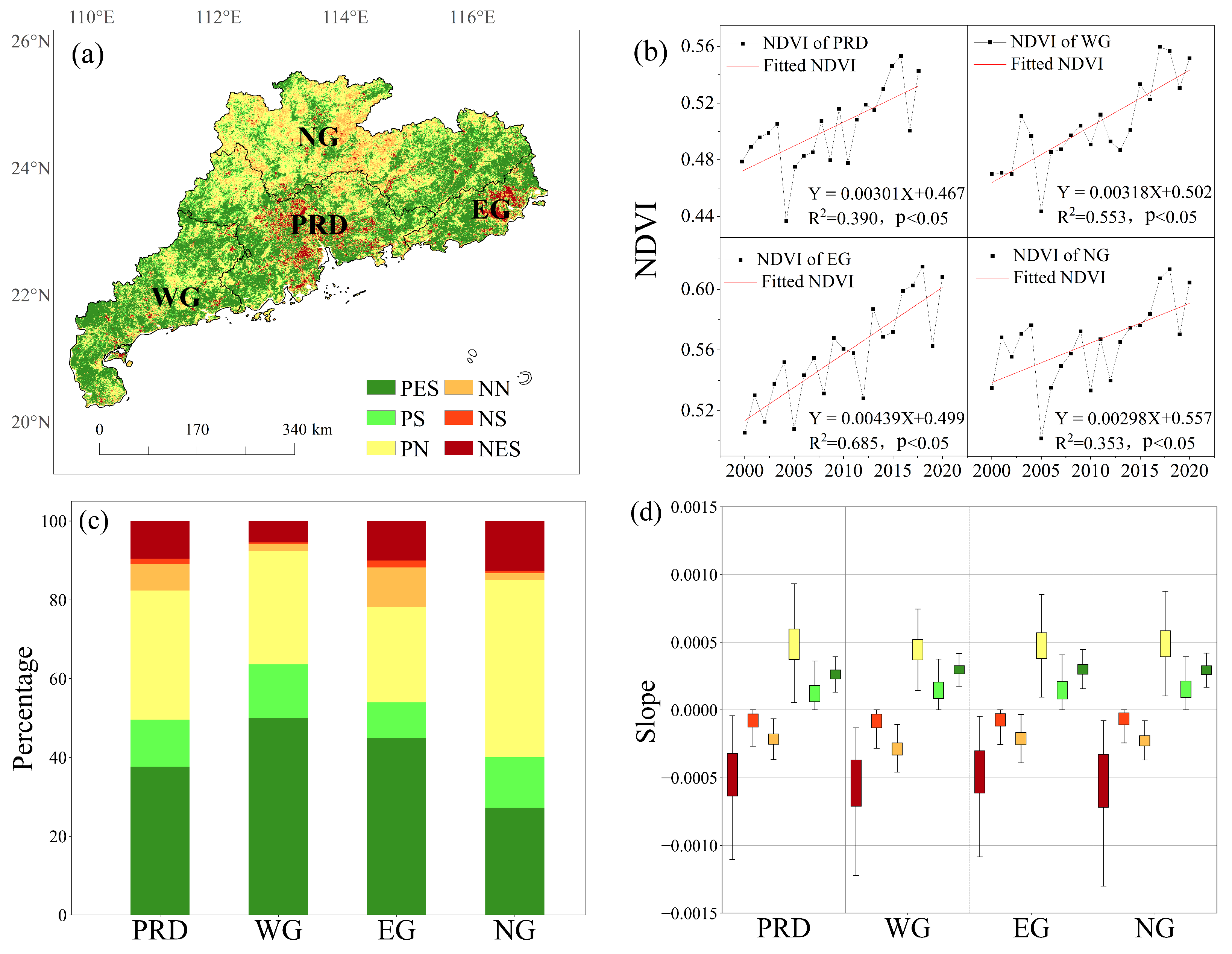
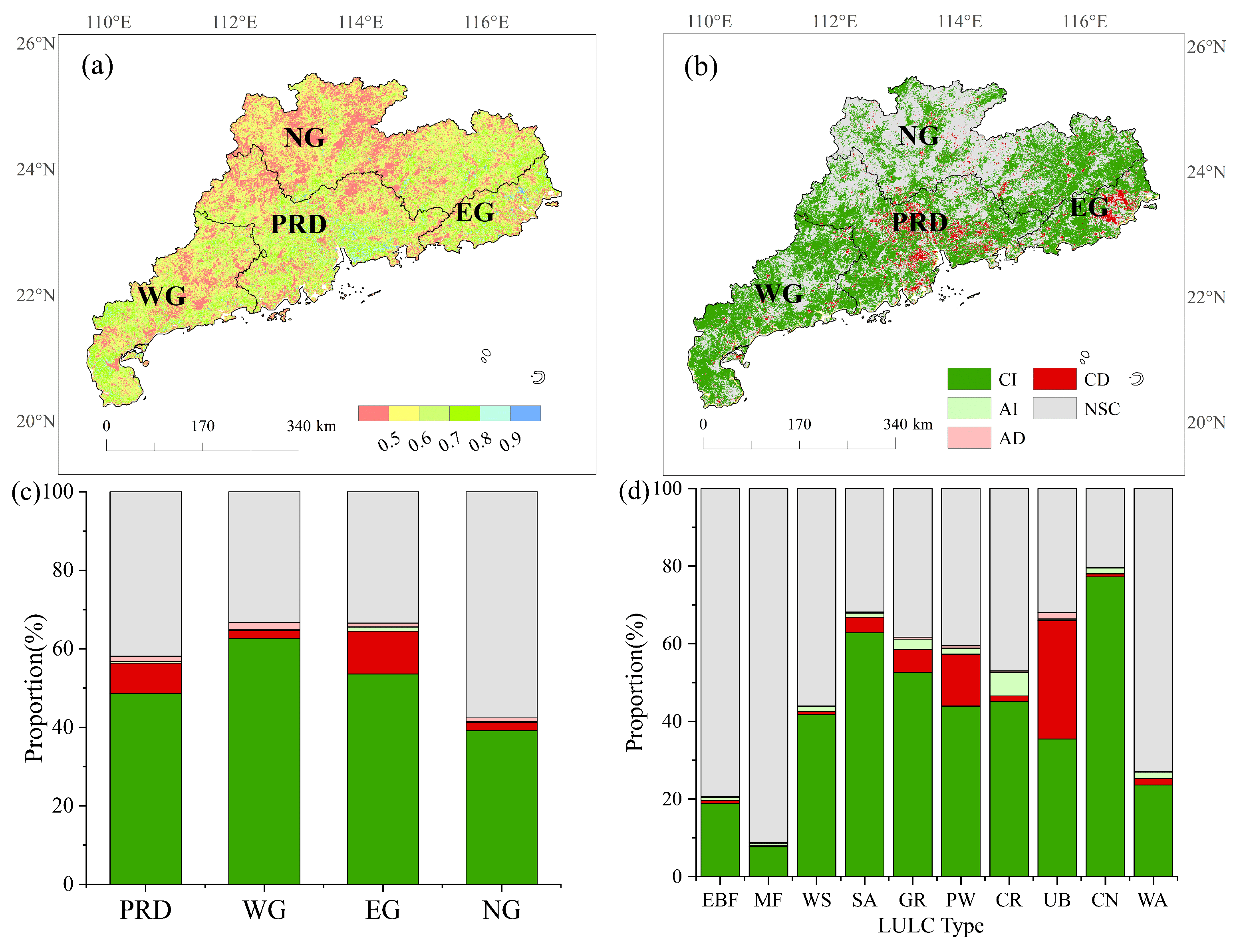
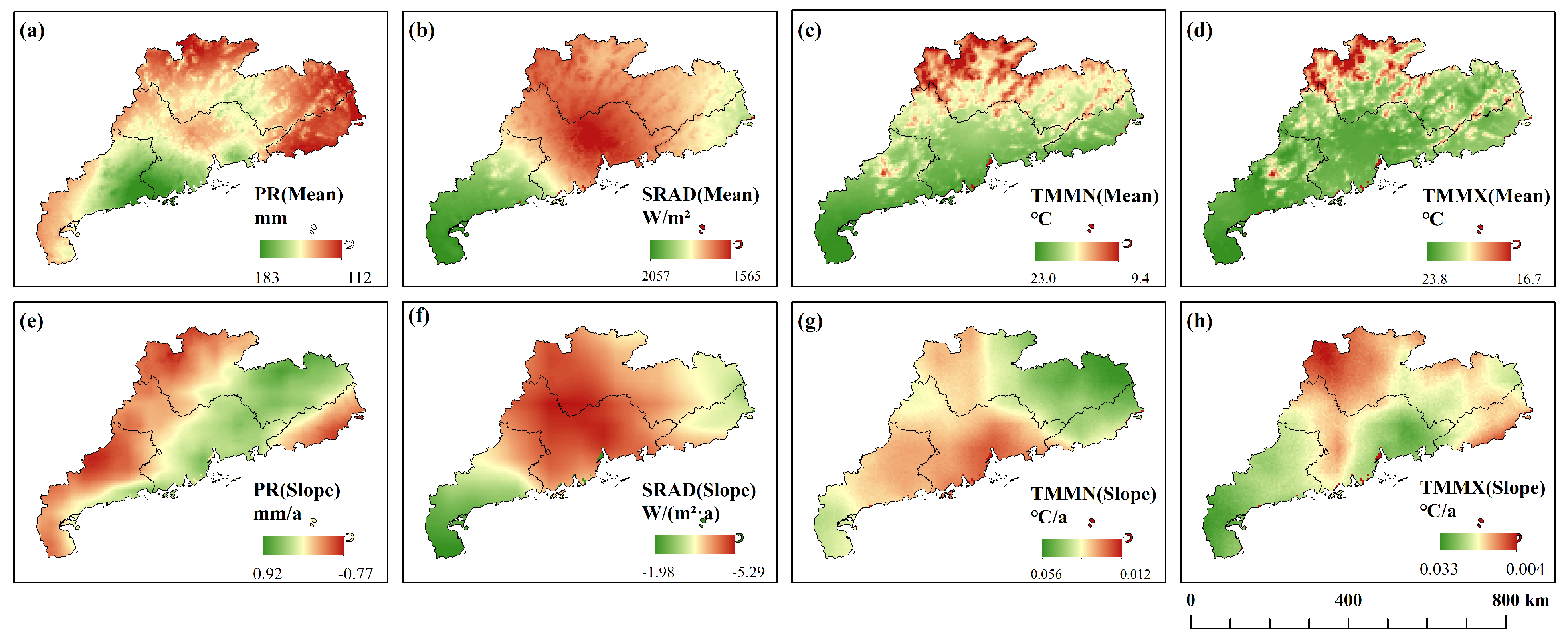
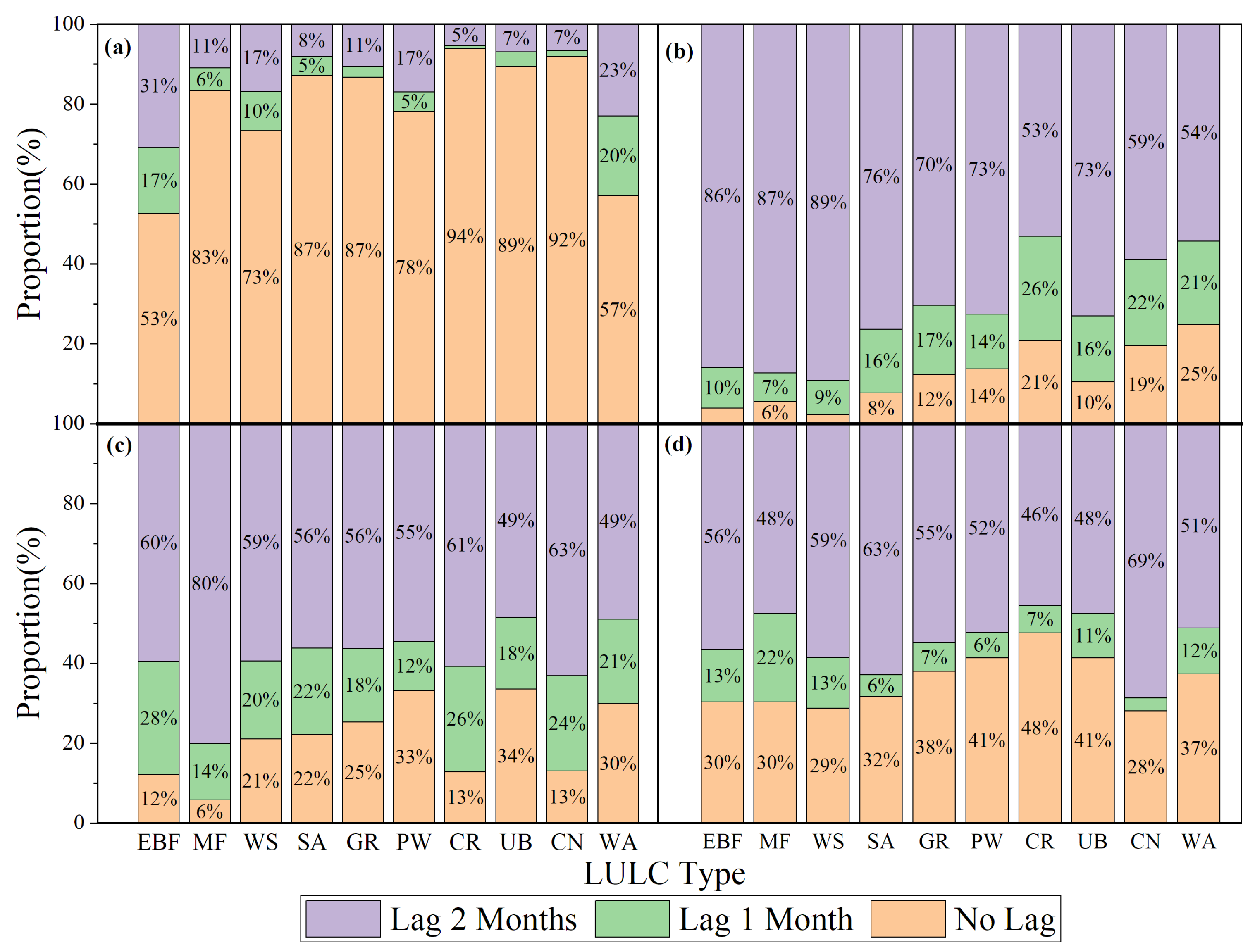
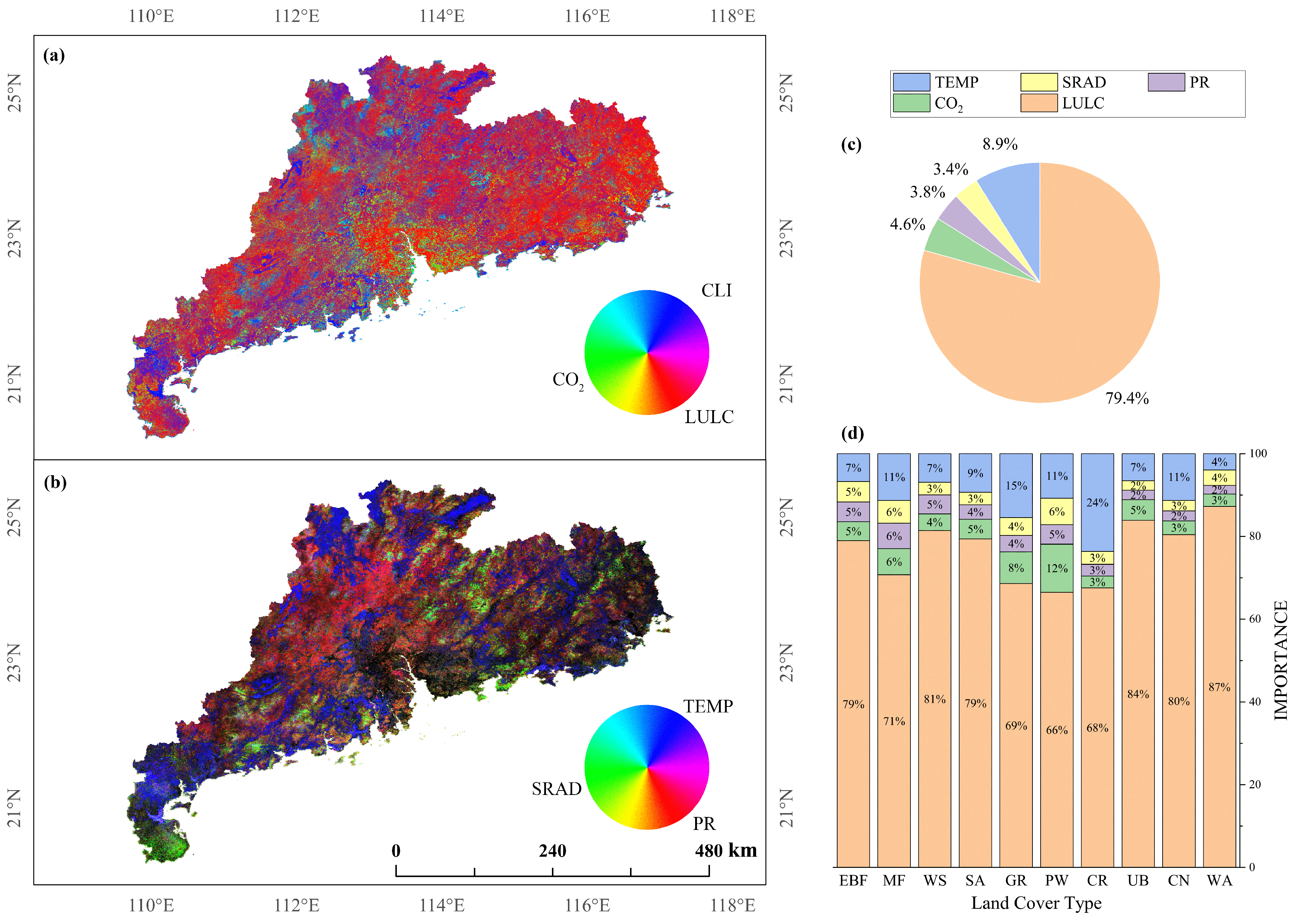
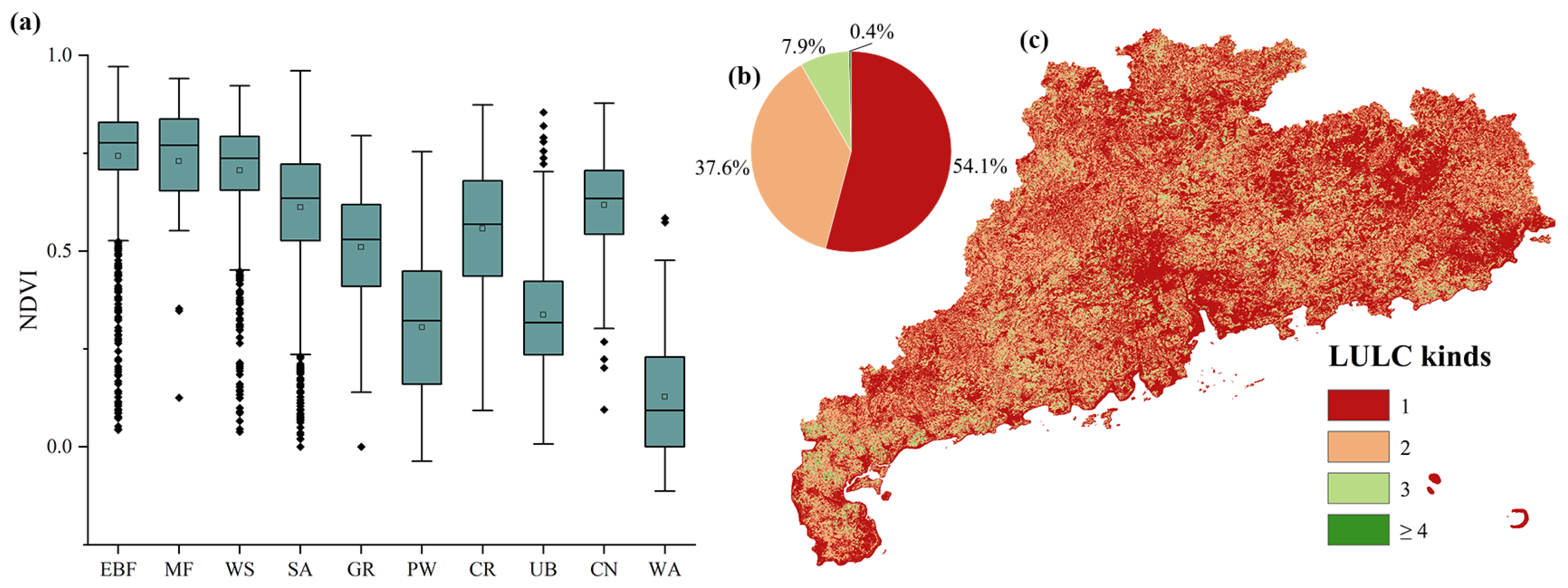
| Pixel Category | Linear Regression Slope | Hurst Exponent |
|---|---|---|
| Continuous Improvement (CI) | >0, significant | ≥0.5 |
| Continuous Deterioration (CD) | <0, significant | ≥0.5 |
| Anti-continuous Improvement (AI) | >0, significant | ≤0.5 |
| Anti-continuous Deterioration (AD) | <0, significant | ≤0.5 |
| No Significant Change (NSC) | not significant | Any |
Publisher’s Note: MDPI stays neutral with regard to jurisdictional claims in published maps and institutional affiliations. |
© 2022 by the authors. Licensee MDPI, Basel, Switzerland. This article is an open access article distributed under the terms and conditions of the Creative Commons Attribution (CC BY) license (https://creativecommons.org/licenses/by/4.0/).
Share and Cite
Li, H.; Li, K.; Zhao, X.; Zhao, J. Changes in Vegetation Greenness and Their Influencing Factors in Southern China. Remote Sens. 2022, 14, 3291. https://doi.org/10.3390/rs14143291
Li H, Li K, Zhao X, Zhao J. Changes in Vegetation Greenness and Their Influencing Factors in Southern China. Remote Sensing. 2022; 14(14):3291. https://doi.org/10.3390/rs14143291
Chicago/Turabian StyleLi, Hao, Kunxi Li, Xiang Zhao, and Jiacheng Zhao. 2022. "Changes in Vegetation Greenness and Their Influencing Factors in Southern China" Remote Sensing 14, no. 14: 3291. https://doi.org/10.3390/rs14143291
APA StyleLi, H., Li, K., Zhao, X., & Zhao, J. (2022). Changes in Vegetation Greenness and Their Influencing Factors in Southern China. Remote Sensing, 14(14), 3291. https://doi.org/10.3390/rs14143291






